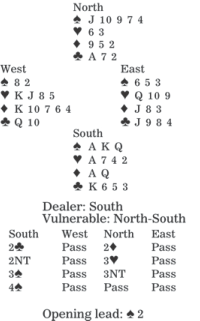The loser can be hard to foresee
By Phillip Alder ( China Daily ) Updated: 2015-07-04 08:39:01

Henri Poincare, a French polymath who died in 1912, said, "It is far better to foresee even without certainty than not to foresee at all."
That is also true at the bridge table. Better, though, is when declarer can foresee exactly how to make his contract. In this deal, the right line is tough to spot.
How should South plan the play in four spades after West leads a trump?
In a perfect world, North-South would end in three no-trump, which has nine top tricks via five spades, one heart, one diamond and two clubs. But after North transfers into spades, then offers a choice of games with three no-trump, South will be nervous of the spade-suit blockage. If North does not have a side entry, three no-trump will fail.
Note West's opening salvo. It is dangerous to lead around to a big, balanced hand. A trump rates to be the safest start that he has.
Declarer has four possible losers: one heart, two diamonds and one club. Maybe clubs will break 3-3, but that is unlikely. Or perhaps the diamond finesse will work; in theory, this is a 50-50 shot, but not in newspaper columns or classes!
South needs to remember that a ruff in the shorter trump hand eliminates a loser and gains an extra trump trick. He should take the first trick, cash his diamond ace, and continue with the diamond queen. West wins and plays another trump, but South takes that, crosses to dummy with a club, and ruffs the last diamond in his hand. Then he cruises home. The queen of diamonds is a red-card herring.
|
|
|
|
|
|
|
|

























 Raymond Zhou:
Raymond Zhou: Pauline D Loh:
Pauline D Loh: Hot Pot
Hot Pot Eco China
Eco China China Dream
China Dream China Face
China Face






